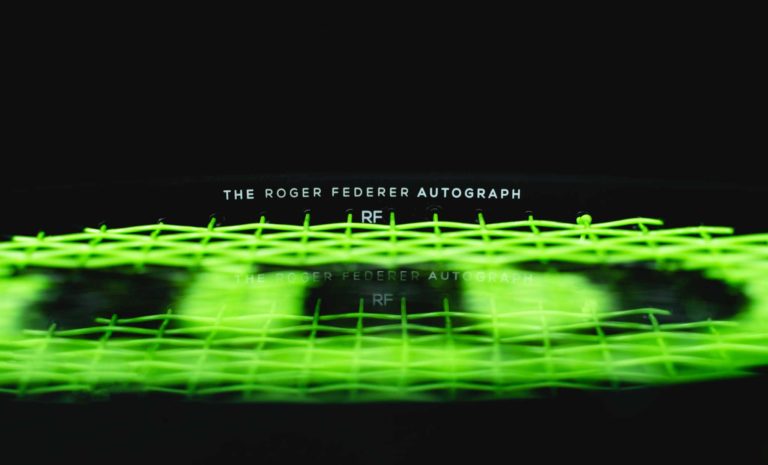Wondering what a string pattern is in tennis and what effect it has on a tennis racket? Well, you’ll be pleased to hear we’ve put together a guide to tennis racket string patterns, including the differences between them and even which ones the pros use on tour.
What is a Tennis Racquet String Pattern?
A tennis string pattern refers to the number of strings in a tennis racquet. A string pattern is made up of vertical strings, called mains, and horizontal string, called crosses. When talking about string patterns in tennis rackets, we always refer to the mains first, then the crosses.
For example, a 16×19 string pattern indicates that a racket has 16 mains and 19 crosses.
Open vs Closed String Patterns
Depending on the number of mains and crosses, a string pattern can be considered open or closed/dense. In essence, rackets with fewer strings are said to have “open string patterns”, while rackets with more strings have a more dense string patterns and are said to have “closed string patterns”.
16×18 and 16×19 string patterns are some of the most common open string patterns available, while the most common closed string pattern you’ll find is likely to be an 18×20 pattern.
How does string pattern affect a tennis racquet?
Generally speaking, open string patterns help generate more spin, power and depth. Closed string patterns provide more control and are better suited to players with flatter strokes.
It’s also worth knowing that closed patterns offer a little more string durability as there are more strings in the frame and they tend to move a little less.
| Open Pattern (16×18 or 16×19) | Closed Pattern (18×20 or Similar) |
| More spin potential | More control |
| More power | More precision |
| Higher launch angle (more height on groundstrokes) | Lower shot trajectory (flatter shot) |
| More forgiving feel (easier on the arm) | Firmer feel |
| Less durability | More durability |
The Most Common Tennis String Patterns
16x19 String Patterns
The 16×19 is probably the most popular string pattern in rackets on the market today. As an ‘open’ string pattern, it offers players a little extra spin and power on their shots, making it easier to keep the ball deeper in the court. It also creates a softer string bed than closed patterns, which provides a softer feel on the ball, which is one of the reasons many players opt for a 16×19 pattern. That being said, there are a couple of disadvantages, which are mainly less tension control and less string durability due to the movement of the strings.
Some of the more popular rackets that feature a 16×19 pattern include the Wilson Pro Staff RF97, the Babolat Pure Aero, Babolat Pure Drive, the Yonex Ezone 98 and Yonex Vcore Pro 97, as well as the Head Graphene 360+ Prestige Pro.
18x20 String Patterns
The 18×20 string pattern is another very popular string pattern and offers players more control on their shots, as well as a little more string durability. It also creates a slightly firmer string bed, which some players may prefer as it can feel a little more responsive and can help with precision shots. However, it doesn’t generate quite as much spin and it also feels a little heavier on the arm and might cause problems for players with wrist or arm injuries.
It’s a pattern that’s particularly useful for players using softer strings like natural gut, synthetic gut or multifilament strings. These days though, most players use naturally firmer polyester strings.
The Head Speed Pro 2022, Wilson Blade 98 18×20, Tecnifibre TF40 and the Head Prestige Pro 2021 all feature 18×20 string patterns.
16x18 String Patterns
The 16×18 string pattern is a little less common. It has fewer cross strings than the traditional 16×19 pattern, making the string bed denser in the sweetspot while being more open towards the outer edges of the frame. That allows even more string movement and better ball pocketing, providing players with huge amounts of spin and power, while not really needing to worry about the ball sailing beyond the baseline.
However, that extra string movement does result in less tension maintenance and often leads to less string durability.
While less common, there are several frames on the market that feature 16×18 patterns, like the Prince Phantom and Volkl V-Cell 8 rackets, to name a couple.
16x20 String Patterns
The 16×20 pattern lies somewhere between the popular 16×19 and 18×20, offering a somewhat of a blend between the two patterns. By having fewer cross strings, the 16×20 still provides plenty of string movement while creating a relatively dense string bed near the sweetspot. It generates a little more spin and power when compared to the 18×20, but offers slightly more control than the more open 16×19.
16×20 frames are also a little less common, though there are still plenty of them out there. The Yonex Vcore 95 (2021), Head Gravity MP Graphene 360+ (2021), Babolat Pure Strike VS 2022 and the Wilson Clash 98 v2 all feature 16×20 patterns.
Other String Patterns
You may also come across a number of other, more open string patters such as a 16×16, 18×17 or even 14×18, to name just a few. They are much less common, though do offer great advantages in the hands of the right player. For example, the Wilson Spin Effect rackets have had great success in generating huge amounts of spin with very open string patterns and are extremely popular tennis rackets, particularly at a recreational level.
Which String Patterns Do The Pro's Use?
To give you an idea of what the pro’s use, here’s a list of the string patterns that some of the best tennis players use in their rackets:
| Player | String Pattern |
| Roger Federer | 16×19 |
| Rafael Nadal | 16×19 |
| Novak Djokovic | 18×19 |
| Andy Murray | 16×19 |
| Daniil Medvedev | 18×19 |
| Alexander Zverev | 18×20 |
| Stefanos Tsitsipas | 18×20 |
| Dominic Thiem | 18×20 |
| Iga Swiatek | 16×19 |
| Naomi Osaka | 16×19 |
| Serena Williams | 18×19 |
| Emma Raducanu | 16×20 |
What is the best string pattern for a tennis racket?
It depends very much on your game style. An open string pattern, like a 16×19, is likely to offer you more power and spin, while a closed pattern, like an 18×20, will offer you more control on your shots. It’s also worth remembering that open patterns create a softer string bed, so they can be a little easier on the arm.
So remember, while strings type and other racket specs have a very large impact on the way a racket plays, something as fundamental as the string patter also plays a huge role when it comes to the overall racket performance.
Hopefully, this has helped you gain a better understanding of tennis racket string patterns, though do feel free to give us a shout out in the comments below if you have any questions at all!


